Attention, scout car crews!!!
I'm going to show you a vehicle that is truly typically English. Let's learn some details about this sturdy little escort and reconnaissance vehicle and its use on the front lines by its fearless crews: Introducing the Humber Scout Car Mk.I!!
 |
| Troubles with maps!! Humber Scout Car Mk.I |
The Humber Scout Car was a British light scout car used in the Second World War. It entered service in 1942 and continued in production until 1945.
.jpg) |
| Humber Scout Car Mk I font: IWM (STT 8284) |
 |
| Humber Scout Car Mk.I |
Designed for reconnaissance, and liaison between armoured units, it provided protection only against light arms fire. More importantly it was small and fast and could quickly evade trouble. It became the shape format for the post war Ferret armoured car which began production in 1952.
 |
| Ferret Scout Car Mk.II - 1959 |
History
Athough at the outbreak of the Second World War the British Army had already selected the Daimler Dingo for production, the need for scout cars could not be met by Daimler alone, so other companies were required to produce similar vehicles.
 |
| A Scout Car Daimler Mk 1 Dingo reconditioned, leaving the REME depot for a road test after a complete overhaul. England - 14/07/1942. font: IWM H 21420 |
One of these companies was Humber which along with other companies in the Rootes Group was already producing armoured cars and the Humber light reconnaissance car. In 1942 they built a vehicle similar to the Dingo in layout. To comply with the official requirement to keep the weight down, the Daimler "Dingo" was open top (the Humber had an unarmoured floor).
.jpg) |
| Humber light reconnaissance car Mk IIIa font: IWM MH 3751 |
The vehicle carried a crew of two, with an emergency seat for a third member. It was equipped with a No. 19 radio set. The armament consisted of one or two Bren light machine gun with a 100-round drum. This was mounted above the roof, and could be operated from inside the vehicle using a system looking similar to bicycle handlebars, where the "brake" levers fired the triggers of the Brens.
.jpg) |
| French patriots help the crew of a Humber scout car spot German positions during mopping-up operations in Le Havre. Notice the single Bren light machine gun with a 100-round drum mounted in the car's roof. France - 12 September 1944. font: IWM (BU 916) |
 |
| The machine gun remote control, similar to that of a bicycle handlebar (red circle) where the "brake" levers activated the Brens triggers. The 100 round Bren drum is in the blue circle. |
 |
| Humber scout car font: IWM KID 830 |
.jpg) |
| Princess Royal stops to talk to a Sergeant driver of a Humber Scout Car of Royal Signals. England -16-10-43 font: IWM (H 33618) |
Production of the vehicles continued until 1945. At least 4.298 were ordered and at least 4.102 delivered, 1.698 of them Mk I. They were used by British armoured units (e.g. the 79th Armoured Division, the 11th Armoured Division and the Guards Armoured Division) for countless tasks.
.jpg) |
| M7 Priest SPH passes a Humber scout car of 79th Armoured Division during Operation Charnwood, the attack on Caen, France. 8 July 1944 font: IWM (B 6657) |
.jpg) |
| German prisoners being brought in on the bonnet of a Humber scout car Caen, France - 9 July 1944 font: IWM (B 6744) |
.jpg) |
| Humber scout car passes a sign warning of the dangers of raising dust, 12 July 1944. font: IWM (B 7018) |
.jpg) |
| A policeman guides a Humber scout car across a bridge over the Odon, 16 July 1944. font: IWM (B 7594) |
 |
| Humber scout car and Comet tank of the 11th Armoured Division, 29th Armoured Brigade, 3rd Royal Tank Regiment in a devastated German town - 30 March 1945 font: IWM BU 2758 |
.jpg) |
| Humber scout car of the 11th Armoured Division, during the advance to Osnabruck, Germany - 2-3 April 1945 font: IWM (BU 3030) |
These agile and versatile vehicles were used by the Canadians, Czechs and Poles in WWII as liaison, escort, command and observation vehicles, including as outposts connecting ground forces and fighter-bomber groups by the Allied Air Forces.
 |
The crew of a Canadian Humber scout car checking the navigation on your campaign map in Falaise, France. 17 August 1944 font: Library and Archives Canada |
 |
Major David V. Currie, VC, of the South Alberta Regiment in a Humber I scout car. - Halte, Netherlands - 12 November 1944 font: Library and Archives Canada |
 |
Unidentified personnel in a Humber Mk. I scout car of the Sherbrooke Fusiliers Regiment - England, 20 April 1944 font: Library and Archives Canada / PA-188675 |
 |
| Polish Humber Scout Car Mk.I from 2nd Armored Division on parade near Loreto, Italy - 15-08-1945. font: Polish National Archives |
%20operating%20from%20a%20Humber%20scout%20car%20in%20No.%2083%20Group's%20sector%20of%20operations%20in%20Normandy.%20%20IWM%20(CL%20565).jpg) |
| Visual Control Post (VCP) from RAF operating from a Humber scout car in No. 83 Group's sector of operations in Normandy. font: IWM (CL 565) |
 |
| Humber scout car from the British 2nd Household Cavalry's RHQ along a road - Bourg Leopold-Hechtel - Belgium font: frame of IWM A70 155-10 |
.jpg) |
| Humber scout car and trucks of 59th Heavy Regiment, Royal Artillery crossing a Bailey Bridge at Dreierwalde, Germany - 6 - 8 April 1945 font: IWM (BU 3335) |
.jpg) |
| Humber scout car crew are greeted by local people in the town of Gace, France - 23 August 1944 font: IWM (B 9635) |
.jpg) |
| Humber scout car crew watch for the enemy in Cormeilles, France as a Churchill tank burns in the town square, 26 August 1944 font: IWM (BU 166) |
%20Division%20during%20the%20advance%20on%20Goch,%2017%20February%201945%20%20IWM%20(B%2014682).jpg) |
| Universal carrier and Humber scout car with infantry of 43rd (Wessex) Division during the advance on Goch, 17 February 1945 font: IWM (B 14682) |
.jpg) |
| Universal carrier and Humber scout car traversing a flooded road between Beek and Kranenburg, 12 February 1944 font: IWM (B 14575) |
.jpg) |
| Humber scout cars lead a convoy moving up through Kevelaer, Germany 4 March 1945 font: IWM (B 15144) |
After the war, some European armies used the Humber,some until the end of the fifties. Most of the vehicles were destroyed in the 1960s when the British Army used them as targets for tank gunnery practice. There are now currently only about 20 known to exist.
Operators
- Belgium
- Canada
- Czechoslovakia
- Denmark
- France
- Greece
- Netherlands
- Norway
- Poland
- South Africa
- United Kingdom
- Indonesia - Inherited from the Netherlands.
Variants
- Mk I.
- Mk II - improved transmission and raised armour over steering wheel.
Specs
| Humber Scout Car | |
|---|---|
| Type | Armoured scout car |
| Production history | |
| Manufacturer | Humber |
| Specifications | |
| Mass | 2.4 tonnes |
| Length | 3.83 m |
| Width | 1.87 m |
| Height | 2.13 m |
| Crew | 2 |
| Armour | up to 14 mm |
Main armament | One or two 0.303 in (7.7 mm) Bren mgs |
| Engine | 6-cyl. petrol 87 hp (65 kW) |
| Power/weight | 25.6 hp/tonne |
| Suspension | 4 x 4 wheeled |
Operational range | 320 km |
| Maximum speed | 100 km/h |
The kit
I built this project using the excellent Humber Scout Car Mk.I Bronco kit (# CB-35009), from 2007.
 |
| The Bronco box art kit is based on photos from the excellent film "A Bridge Too Far", starring Michael Caine. |
 |
| Michael Caine (as Lieutenant-Colonel J.O.E. Vandeleur) in his Humber Scout Car, in the war movie "A Bridge Too Far" (1977). |
The kit is excellent, very well injected. My kit came with a figure of the commander made of polyurethane resin, as well as a good PE sheet and great decal options, but with vinyl tires.
| Kit parts |
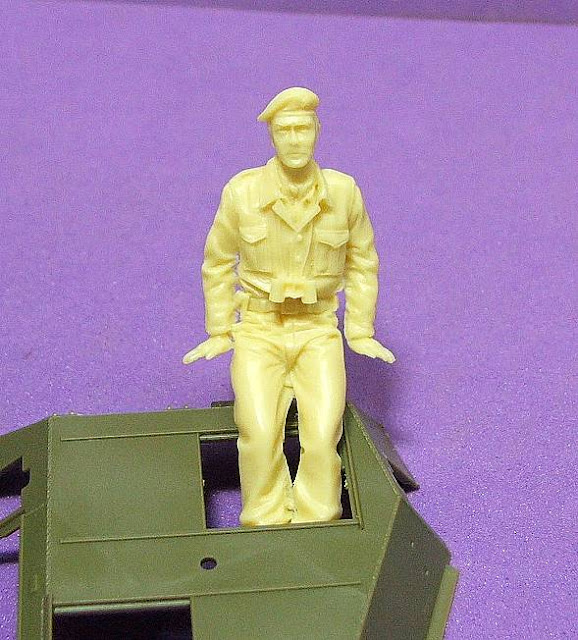 |
| The "Michael Caine" is well cast in polyurethane resin, with good detail and no bubbles... |
The decal sheet is excellent, with 6 marking options: 1 post-war Danish, 4 WWII British and one post-war marking, namely:
- Hæren - 3 Gardehusarregimentet - Royal Danish Army - 1950
- 3 Gardehusarregimentet
- 1st Guards AD - 1945
- 11th AD, 29 Arm. Brig., 3RTR, RHQ "CEREBRAL" - 1945
- 2nd AFV Driving & Maintenance School - Lulworth - 1943
- 54th AT Reg., 78 Inf. Div. - 1944
- C Sqn., 4th Hussars - Malayan Emergency - 1950
 |
| Decal sheet |
 |
| Vinyl tire |
 |
| PE sheet |
 |
 |
| The hull tub is well injected, with few problems... The pin marks will be covered by other parts and a small adjustment is necessary in the engine firewall (red arrow). |
 |
| The chassis being built, with internal details being adjusted... |
 |
| Front suspension and front transmission |
 |
| The cockpit showing its external details... |
 |
| Front axle alignment: a fundamental detail!!! |
 |
| Our little beast can't stay crooked!!! |
 |
| A dry-run with the cockpit, testing the fit!! Notice the rear suspension and axle in position... |
 |
| Internal details...I'll leave some hatches open to allow a view of the kit's excellent interior. |
 |
| The car is very beautiful!! |
 |
| Painting and detailing of the interior... front right details. Notice the radio. |
 |
| Painting and detailing of the interior... Left details. Notice the ammo drums and .45 Thompson MG. |
 |
| Painting and detailing of the interior... roof details. Notice the machine gun remote control, similar to that of a bicycle handlebar, in the middle. |
 |
| Closing the casemate... |
 |
| Notice the hatches... |
While researching our brave warrior, I noticed the front brake lines, made of flexible tubes ringed with metal. I decided to reproduce this detail in our model...
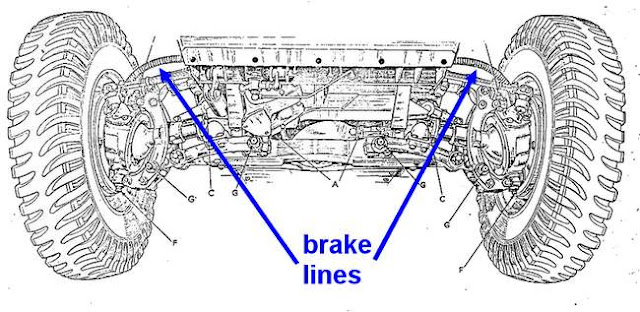 |
| The Devil is in the details!!! |
We will use a thin copper wire as the "tube" and extra-thin copper wires as the annular metal protection. Using a utility knife handle as support...
 |
| We will wind the extra-fine wire onto the copper wire by turning the handle of the knife. |
 |
| Schematic diagram... |
 |
| And brake lines installed in their respective positions... |
 |
| Very good indeed!!! Left front view |
 |
| Righjt front view. Notice the lockers of the hatches, in PE, in position (blue arrows) |
The kit features a very well detailed engine, fuel tank and cooling system, but I chose not to leave the engine hatches open for aesthetic reasons. Therefore, these details will not be added. The engine will be reserved for future scratch projects.
 |
| Engine, fuel tank and cooling system very well detailed. |
 |
| Engine hood closed. |
 |
| Protecting open areas with toilet paper for external painting... |
 |
| Protecting open areas with toilet paper for external painting... |
 |
| Applying shades of green from the base color... left front view |
 |
| Applying shades of green from the base color... right front view |
For our little girl, I chose the markings and colors of the Black Bulls: the glorious 11th Armored Division, fighting around Lubeck, Germany, in early May 1945. As always, I like to make a color and marking guide for my project.
 |
| Panzerserra Colrs & Markings Guide Humber Scout Car Mk.I |
 |
| After two or three coats of Pledge, to avoid silvering, I applied the decals as indicated. front left view |
 |
| Decals - front right view |
 |
| Decals - rear view |
 |
| Starting the wash and weathering |
 |
| Right view |
 |
| Rear view |
 |
| Top view |
 |
| .303 Bren light machine gun, with curve ammo magazine |
 |
| Belly details... |
And after a discreet weathering, with you Humber Scout Car Mk.I CEREBRAL, from 11th Armoured Division, 29th Armoured Brigade, 3rd Royal Tank Regiment, fighting in the vicinity of Lubeck, Germany, in early May, 1945.
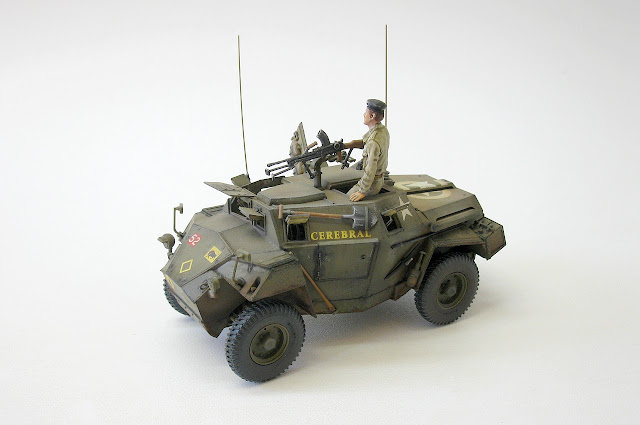 |
| Humber Scout Car Mk.I CEREBRAL - 11th Armoured Division 29th Armoured Brigade - 3rd Royal Tank Regiment Lubeck, German - May, 1945. |
 |
| Humber Scout Car Mk.I front left view |
 |
| Humber Scout Car Mk.I front right view |
 |
| Humber Scout Car Mk.I front right view |
 |
| Humber Scout Car Mk.I left view |
 |
| Humber Scout Car Mk.I rear left view |
 |
| Humber Scout Car Mk.I rear right view |
 |
| Humber Scout Car Mk.I right view |
 |
| Humber Scout Car Mk.I rear top right view |
 |
| Humber Scout Car Mk.I with Kojak |
 |
| Humber Scout Car Mk.I with M8 Greyhound 6x6 Light Armored Car. |
 |
| Humber Scout Car Mk.I CEREBRAL - 11th Armoured Division 29th Armoured Brigade - 3rd Royal Tank Regiment Lubeck, German - May, 1945. |
See you in the next project!!!

.jpg)
.jpg)
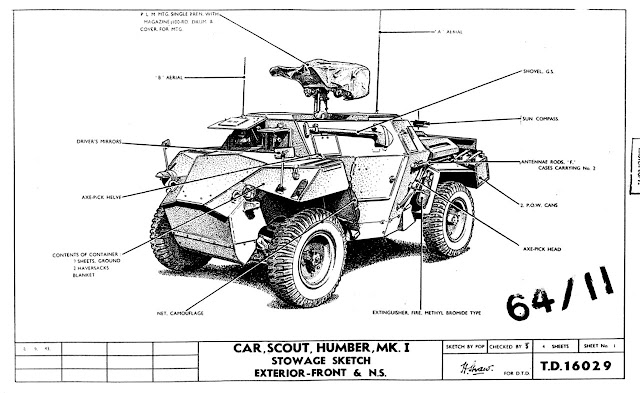

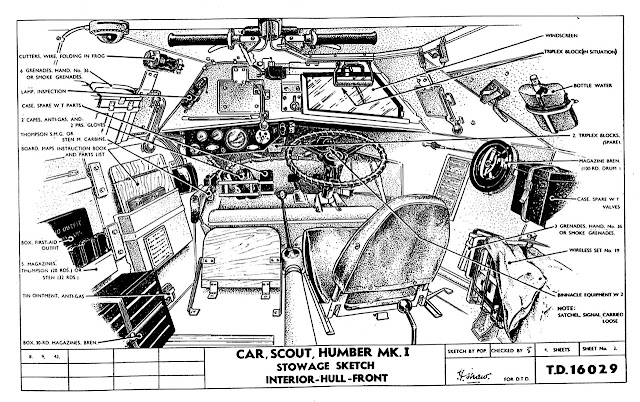

.jpg)

.jpg)


